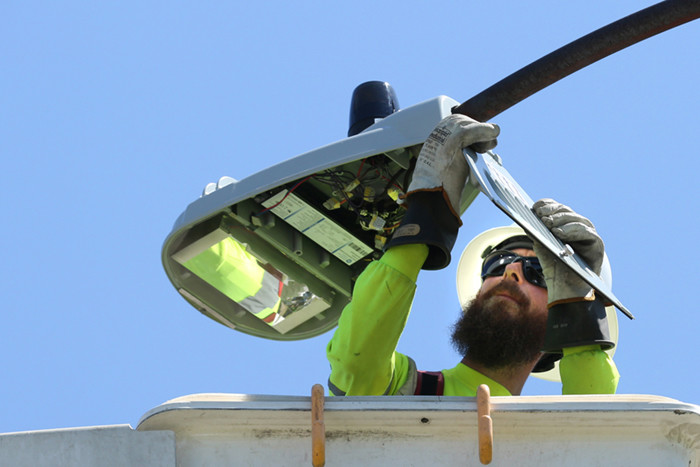Cleveland Mayor Frank G. Jackson says he’s not looking to “buy toys.”
“There are endless possibilities to smart cities technologies,” says Jackson, who has led the city since 2006. “But I’m not trying to buy toys. What we’re looking at is not a fad but something that will have substantive value for what we’re trying to get done.”
Jackson’s administration released its extensive Smart City Cleveland plan in 2016, covering areas like traffic, transit, environmental sensing, smart grids and smart communications. But leaders have been deliberate about their approach, and the city is just now in the midst of its first major smart cities deployment — a $35 million initiative dubbed Safe Smart CLE. Through this project, the city is installing 61,000 LED streetlights and 1,000 security cameras, all tied together with a smart network.
Workers began installing equipment last summer, and the city has plans to finish the implementation around the end of this year. But citizens are already benefiting from improved lighting and public safety response, and the city anticipates dramatic reductions in both its electricity consumption and its maintenance costs for lighting.
READ MORE: How can intelligent street lighting help cities save money and enhance services?
Smart City Plans Focus on Benefits of Technology
Cleveland leaders moved forward with the Safe Smart CLE project for a number of reasons that extend well beyond the opportunity to make the city’s operations more sustainable. For one, the LED streetlights are projected to cut electricity consumption by approximately 40 percent, potentially resulting in a significant cost savings.
Also, city officials will be able to see when bulbs go out and send crews to replace them — a huge improvement from the previous complaint-driven system, which Jackson says “wasn’t very functional.” The old lightbulbs needed to be replaced once or twice each year; the new LED lights are expected to last seven to 10 years, helping to cut down on maintenance and support costs.
Cleveland is installing 61,000 LED streetlights and 1,000 security cameras, all tied together with a smart network. Source: City of Cleveland
The city is concentrating its security camera deployment around 22 recreation centers and a handful of major parks, providing an invaluable resource to Cleveland’s new real-time crime center. By placing the cameras on city-owned light poles, officials are saving on costs for establishing electrical connections.
“One of the biggest assets we have are those light poles, which the city owns through Cleveland Public Power,” says Cleveland CIO Donald Phillips. “The attachment points alone were a huge savings. Just being able to attach to something that had built-in power — normally you’d have to get easements and all kinds of licenses to be able to do that. This made the project much smoother.”
Cleveland Conducted Outreach on Smart City Solutions
The city conducted extensive testing and evaluation to make sure the solution would both serve residents and assist with public safety.
“When we did our pilot, we put up the first 1,000 LED lights and evaluated the system, both from a maintenance and operations view and then from a customer care point of view,” says Darnell Brown, COO for the city. “We had a lot of feedback from the public, which caused us to change the lighting to more clearly illuminate the sidewalk. That has been a tremendous benefit.”
The police department also actively participated in the rollout, not only helping to determine the best camera angles but also influencing the lighting solution.
“We brought out members of the real-time crime center, the homicide unit and sometimes the bomb squad to evaluate the lighting proposed by the vendors,” says Harold Pretel, deputy chief of homeland special operations for the Cleveland Division of Police. “We looked at different lighting strengths and conditions and how those affect different colors of clothing and illuminate license plates. We made sure the solution we were adopting was viable for assisting with investigations.”
“It was a complete integration,” Phillips says. “These systems are parallel. The police department went out with their investigative units to different areas in the city and said, ‘OK, we need the correct lighting, the correct brightness. If we had a crime and we wanted to do an investigation, is this light bright enough, is this light the right color, will it work with our cameras?’ Even where the technology wasn’t physically tied together, process was tied together.”
Tech Supports Clear Goals Within City Initiatives
Together, the LED lights and cameras are already helping the city’s real-time crime center to support officers and detectives as they respond to incidents. In one case, officials actually witnessed a homicide at a gas station via the security cameras.
“They were able to give that information to investigators as they arrived,” Pretel says. “Without that, those investigators could not have asked the appropriate questions to the suspects, and it certainly made everything a lot more cohesive. The entire investigative process was sped up. The cameras allow the real-time crime center to see events as they unfold.”
The city runs the LED streetlights at 50 percent brightness, and officials have the flexibility to turn them up or down on demand for public safety purposes — such as assisting with investigations or improving visibility for major events.
While it’s too early for clear metrics, Pretel is hoping that the Safe Smart CLE initiative will not only speed up investigations but also ultimately result in more successful prosecutions. “The No. 1 goal is a reduction of crime in the hotspot areas,” he says. “No. 2 is a shorter investigative timeline and better prosecutions. It makes for a better case if you have excellent digital evidence to prove that something did or did not happen.”
Cleveland leaders are now studying other ways to advance smart city initiatives, including smart parking meters, electric vehicles and environmental sensors. And the city is building out the Safe Smart CLE deployment with standardized equipment that will allow it to easily add new peripherals, such as gunshot detection devices.
Whatever the city does next, one thing is sure: Leaders will take the same approach as they did with Safe Smart CLE — carefully evaluating solutions that will help achieve specific goals.
“For us, this was a very practical opportunity to save money, improve operations and enhance policing,” Jackson says. “That’s what it’s all about.”














